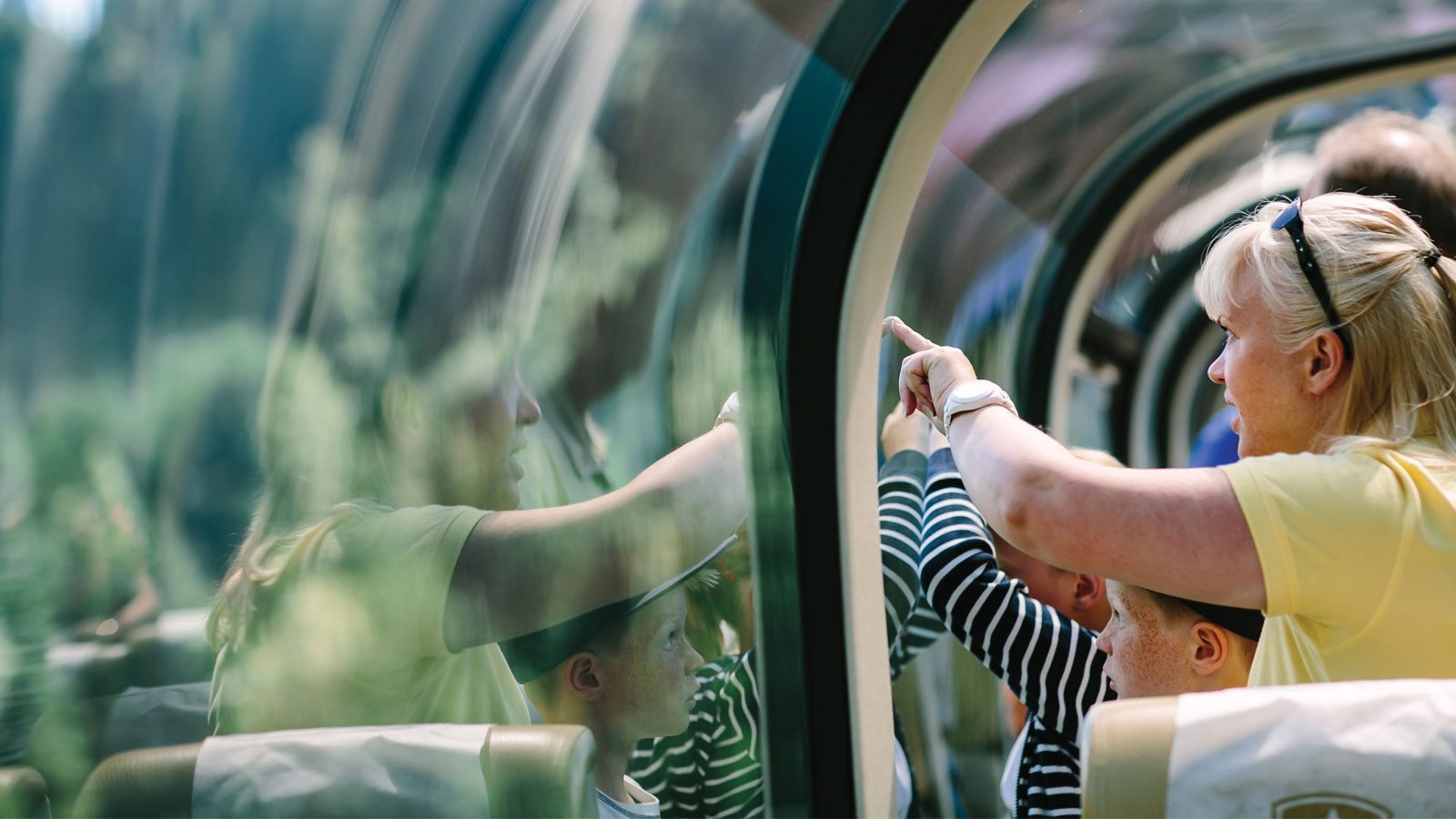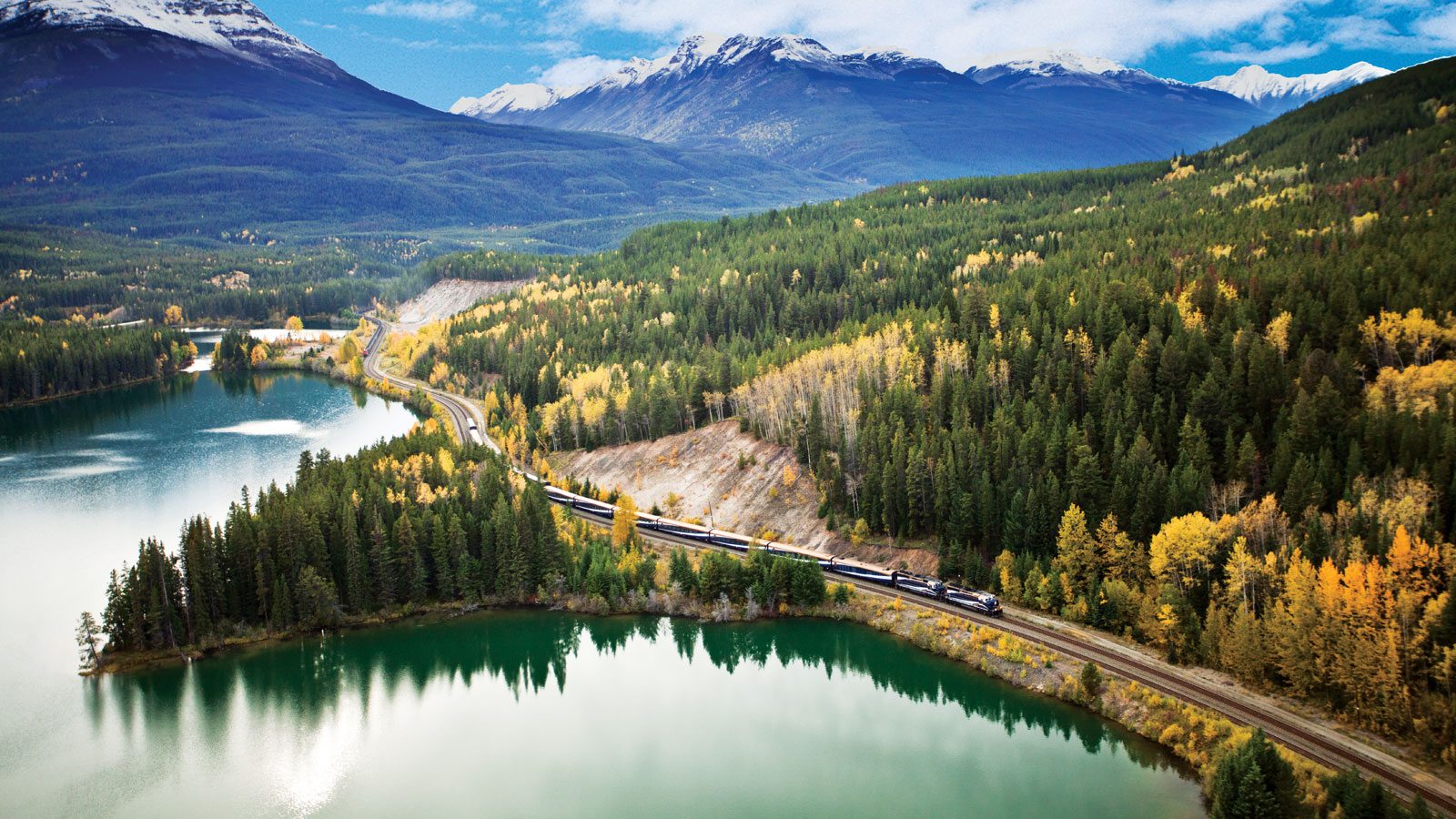The train slowly rolls out of Rocky Mountaineer’s Vancouver Station. We begin travelling away from the Pacific and through the city toward the lush Fraser Valley. As we settle into our seats—stretching our legs, readying books to read and saying hello to fellow passengers across the aisle—the urban landscape turns into flat green farmland. The train picks up speed.
One of the smiling young hosts picks up the microphone to point out Washington’s Mount Baker, located in the Cascade mountain range, 65 kilometres to the south. The Australians, Americans and Europeans on board jump up to snap photos of the snow-capped peak in the distance. Those of us who’ve driven through the Rockies exchange smiles, having passed by these views many times before.
We know what’s coming.
We’re on a two-day, five-star trip aboard the Rocky Mountaineer from Vancouver to Banff.
We will climb to 1,626 metres above sea level, winding our way through the spectacular Rocky Mountains, a tall, rugged and relatively young range of peaks that haven’t yet been weathered by thousands of years of wear and tear.
Though we don’t know it yet, we’ll see bighorn sheep, elk, eagles and a bear. Our luxury train will make stops on the tracks to allow rumbling freight trains full of potash and grain to pass. We’ll learn about First Nations people who’ve lived here for millennia and those who came later, including infamous fur traders, train robbers, gold miners and train builders.
But first, the bar cart.
You don’t have to order a Caesar or mimosa—it is only 10 a.m., after all. But you may feel like toasting the gorgeous scenery and your good fortune. We’re sitting in comfortable seats with more legroom than one person needs, peering through a glass-domed rail car at some of North America’s most spectacular alpine scenery.

Our train rides parallel to the Trans-Canada Highway, a route I’ve seen countless times from behind the wheel. But as the tracks wend through locations inaccessible to cars, the view takes on new angles and I discover previously unseen details.
We pass the little white Kilby General Store, built on stilts in 1906 so that it could survive floods from the Harrison River (it did). We roll through Agassiz, named for an Englishman who hoped to find gold on the river banks (he did not—and switched to ranching). We pass the town of Hope, which was founded as Fort Hope in 1848 by trappers hoping it would be a good route for the Hudson’s Bay Company’s fur trade (it was).
The Canadians on board try to recall high school history, while everyone else gets up to speed flipping through the Mile Post, the onboard newspaper. A better name might be the Everything You Want to Know About Our Route Post, as it features maps, stories and practical tips, including a guide to wildlife we may encounter along the way—grizzlies, black bears, wolves and even the mythical Sasquatch.
Our onboard hosts regale us with witty stories about the sights whizzing by our windows. We learn about incredible feats of man and nature, including beaver dams, bears with GPS collars, and sensors that can feel rockslides before they happen. While the jokes are just this side of corny, our hosts are exceedingly pleasant as they serve gourmet snacks and beverages. We don’t really need the snacks—we are tremendously well fed in the GoldLeaf dining car—but we eat them anyway. There’s no Wi-Fi on board, but no one seems to notice, caught up as we are in the tall tales and the feel of the train wheels underfoot.
Planning a Rocky Mountaineer journey?
Stay on the right track with advice from AMA Travel:
Call 1-844-771-1522 or visit AMATravel.ca/RockyTrain
The tracks turn north to follow the Fraser River. It’s named for Simon Fraser, a young Scottish explorer who was sent west more than 200 years ago. His goal? To find a waterway to expand the North West Company, a fur-trading rival of the Hudson’s Bay Company. “I have been for a long time among the Rocky Mountains, but I have never seen anything to equal this country, for I cannot find words to describe our situations at times,” young Fraser wrote in his diary in 1808. “We had to pass where no human being should venture.”
These days, more than 100,000 humans venture aboard the Rocky Mountaineer every year, from April to October. Any given car is brimming with Aussies, Brits and Americans.
As you wander around the car, swapping seats and chatting, you’ll encounter accents from across the country and around the world. We take turns visiting the vestibules between the cars to feel the wind in our hair and snap a few more photos.
At lunch, we make the trek from the domed car down a little spiral staircase to the GoldLeaf dining car—with its white linens, silver cutlery and even an A.Y. Jackson print on the wall. But attention soon diverts from the Group of Seven artwork as we pass by Hell’s Gate, the notorious spot where the Fraser narrows and river water is forced to crash through a steep gorge.
We cross over the river on a grand century-old arch bridge, marvelling at both the engineers who built it and the churning water below. We pass Avalanche Alley, where trains used to slow down so men could reach out and grab Morse code messages clipped to telegraph poles (they have a different use now—our host points out a giant osprey nest atop one of them).

As we roll into Kamloops around dinnertime, people wave to us from playgrounds and backyards. There are even a few guys on horses with red shirts and white bandanas waiting to say hello—the Kamloops Mounted Patrol, a volunteer welcoming committee. We hop off the train for dinner and spend the night at a hotel. The next morning, we steady our train legs as we climb back aboard, hungry for breakfast and the ten-hour journey to Banff.
We pass the headwaters of the Adams River. Salmon swim upstream for more than 500 kilometres from the Pacific to spawn here. We roll past the spot where notorious bandit Billy Miner robbed the wrong train in 1906, netting only $15 and some liver pills.
Dining Car
Learn what it takes to prepare and serve the gourmet meals that make your Rocky Mountaineer experience even more memorable!
The train slows so we can see the monument that marks one of Canada’s earliest photo ops: The spot where the Last Spike was hammered into the CP rail line in 1885. (In fact, it was the second last spike. The first one was bent in the installation so someone had to haul out another). We trundle through Revelstoke, named for the British banker whose money helped keep the dream of a national railway alive.
And what a magnificent dream it was. The Rocky Mountaineer winds along rivers, raging through the mountains, passing through tunnels that were blasted through the rock. We hold our breath as we descend into the sudden blackness of the Connaught Tunnel in Rogers Pass. When we emerge eight kilometres later, we gasp and cheer when our host cracks a joke: “Why is it called the Connaught tunnel? Because we cannot see!”
Post-tunnel, we see so much that our collective jaws drop. Mountain goats perch on the rock above us. Someone shouts “Deer to the right!” A woman standing sideways in the car shouts back excitedly, “Which right?” Someone even spots a bear. The sighting is over as quickly as it’s announced, but a few lucky passengers are happy to share their photos of a blurry creature in the bush.

We’re back in the domed car when we reach the Continental Divide, one of the highest points in North America. Nearly the entire train stands to celebrate the point at which rivers flow either west to the Pacific or east to the Atlantic. As cameras click, I quickly lose count of the “wows” heard in the crowd. A young American woman says to no one in particular, “Well done, Canada.” I can’t help feeling a little patriotic pride.
About 35 kilometres down the track, we learn that the gorgeous castle-shaped mountain we’re admiring was renamed Mount Eisenhower after the Second World War to honour the American general who commanded the Allies. But before the Americans on board get too excited, we’re told Ottawa changed its mind 30 years later and reinstated the original name, Castle Mountain.
As the train arrives at the restored rail station in Banff National Park, we collect our things—the books we didn’t bother opening, new friends’ business cards. We also collect our thoughts. Those of us who have travelled through the Rockies many times before share another little smile. We thought we knew what to expect on our journey through the mountains. Turns out, we only had an inkling.
ROCKY MOUNTAINEER ESSENTIALS
Book
• Earn twice by using your card at select AMARewards partners
Stay
• In Banff, get exclusive member-only hotel deals and packages
Do
• Banff Upper Hot Springs: Save 15% on regular admission
• Visit AMARewards.ca for more details and fun activities
